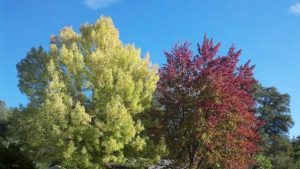While I certainly don’t cherish the end of summer, I look forward to the vivid autumn colors that appear, making the landscape look like a painting. As much as I dread the shorter days and longer nights, I know the cycle (called photoperiodism) is required for the transformation that occurs this time of year. Biochemical processes start to prepare deciduous trees and shrubs for winter dormancy. As chlorophyll production decreases and photosynthesis stops with shorter daylight hours, leaf pigments that were hidden by chlorophyll are revealed. Of course, plants have different types and amounts of pigments so the autumn show is quite varied for different species – and even varieties within a species.

Now is the time to start planning for your own autumn show. Buy plants that have already started changing . Just keep in mind that other factors, such as temperature and rainfall, can affect the timing and intensity of colors, so it may vary from year to year.
Chinese Pistachio or Pistache (Pistacia chinensis): This tree is very tolerant to challenging growth conditions and is quite popular and fairly common around here. The town of Sonora is lit up with brilliant shades of bright oranges, scarlet, crimson and yellow, thanks to these trees. Female trees produce berries that turn reddish-purple in the fall and are relished by birds. They also make great decorations.

Sweet Gum (Liquidambar styraciflua): This nicely-shaped tree can easily be identified by the star-shaped leaves that have five sharply-pointed lobes. It’s a beautiful shade tree that blazes yellow, orange, purple and fire engine red in the fall. Although the hard, woody and spiny fruit can be a bit messy, it is loved by finches, sparrows, mourning doves, wild turkeys and squirrels.
Crape myrtle (Lagerstroemia indica): Admired as a dramatic and profusely-blooming tree in the summer, it also bursts into glorious autumn color. The dense green canopy transforms into hues of bright oranges, reds and purples, which make the unique bark that exfoliates in late summer stand out even more.
Japanese Maple (Acer palmatum): There are hundreds of cultivars of these dramatic, yet graceful trees and shrubs that are revered by many people. There are countless variations in size, form, texture and color, and there are even some that you can grow in pots for years. The varieties that have strong color changes in the fall can be absolutely enchanting. Three cultivars that reliably produce intense fall color are: Sango kaku, also known as the Coral Bark Maple; Red Pygmy, an outstanding dwarf and Seiryo, also known as Japanese lace-leaf maple.
Honorable mentions in the tree category are: Sugar Maple (Acer saccharum); Red Maple (Acer rubrum); Paperbark Maple (Acer griseum); Dogwood (Cornus nuttallii); Smokebush (Cotinus coggygria); Raywood Ash (Fraxinus oxycarpa ‘Raywood’) and Black Oak (Quercus kelloggii).
Colorful autumn shrubs and vines to try are: Oakleaf Hydrangea (Hydrangea quericifolia); Viburnum (Viburnum trilobum); Sumac (Rhus typhina); and Wild California Grape ‘Roger’s Red’ (Vitis californica).
Whether it’s in your own yard or in our outstanding Sierra Nevada foothills, get out and watch the landscape light up in a kaleidoscope of color.
Kathy Nunes is a University of California Cooperative Extension Master Gardener of Tuolumne County who loves to go for autumn drives.




